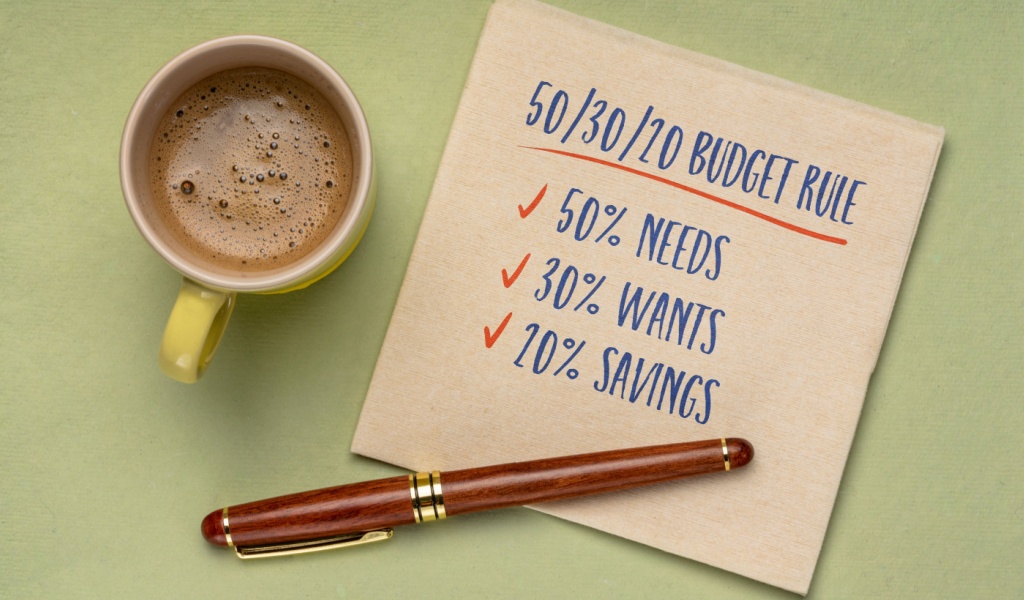Ah, budgeting. It weighs heavily on our minds, particularly in today’s economy. If you’re new to budgeting, figuring out how to manage your money can sometimes appear overwhelming. Organizing your income and expenses is hard enough, but making decisions about how you spend your money is even more complicated.
When you need help starting a budget, you can look at the 50/30/20 rule for guidance. It is a percentage-based budget that divides your monthly income into categories. The idea is to divide your income into three categories: spend 50% on needs, 30% on wants, and 20% on savings.
Let’s explore this concept further.

50% for Needs
By needs, we mean your necessities, including your living expenses, which should account for 50% of your after-tax income. Many people confuse needs with wants. Needs are things you cannot do without. These include expenditures revolving around healthcare, utilities, groceries, transportation costs, student loan payments, rent or mortgage, credit card and debt payments, insurance, childcare, etc.
The money you spend on your needs will change over time. For example, if you settle your student loan, you will have the extra money in your needs budget to allocate for other expenses. Consider making higher monthly payments to pay off your mortgage to settle your debts faster.
30% for Wants
While needs are things you cannot make do without, wants are things you’d like to have but are not required to survive. It’s also different from what you save for, such as significant expenses like buying a house or taking an extended vacation. It might be challenging to differentiate between needs and wants, but here’s a quick example. Wants are things you would like to have to upgrade your life. For example, eating out at a restaurant rather than cooking at home or splurging on a few OTT subscriptions rather than sticking to cable TV. These extras that you pay for are things that make your life a little more enjoyable.
Other examples of wants include pampering yourself with a spa treatment once a month, spending on designer clothing, gym memberships, tickets to sporting events, and so on.
While saving is important, sometimes you deserve to do something nice for yourself. An occasional splurge is one way of rewarding yourself for working hard, and it can also motivate you to work harder to accomplish your goals!
20% for Savings
Finally, the remaining 20% of your after-tax income should go into savings that can be used to accomplish your big long-term goals, including a rainy day fund. You must have at least three months of emergency savings in hand so you’re prepared to tackle any unforeseen circumstances like losing your job or facing hefty hospital bills. Beyond that, you can also focus on meeting your distant financial goals, like saving for retirement.
Some other examples that fall into the savings category include making IRA contributions to a mutual fund account, trying to settle debt repayments beyond the minimum payment, investing in the stock market, and setting aside funds to purchase physical property.

Advantages of the 50/30/20 Budget Rule
Ease Of Use
The 50/30/20 budgeting guideline is a straightforward framework that is easy to understand and apply. There is no need for complicated calculations; even someone with hardly any financial aptitude can adhere to this concept!
Convenient Money Management
When you stick to a budget, you’re better prepared to manage your money in a balanced way. As a result, you can rest assured that your necessities are covered and that you’re saving actively for your future while still having fun with your finances.
Allows You To Prioritize Important Expenses
The 50/30/20 rule ensures that your fundamental needs are covered without going above budget or falling into debt.
Emphasizes Saving
You ensure that you allocate a percentage of your income to set up an emergency fund, invest, prepare for retirement, and reach your other financial goals. This is an efficient way of building a safety net in unforeseen emergencies.
Long-term Financial Security
When you set aside 20% of your earnings to prioritize your financial future, you’re establishing a healthy saving habit for your future.
Is The 50/30/20 Budget Rule Right For Me?
While this is an excellent budgeting technique, it may not work for your specific monthly expenses. Depending on where you live, how many members are in your family, and your income, you might need to allocate more than 50% of your income to your needs. If you live in an expensive area, a big chunk of your income will likely go to housing, so your needs may not fit under 50% of your income. In such circumstances, you may have to adjust the percentages to suit your situation.
Remember, you don’t have to hit the exact percentages. It’s all about tackling your financial goals by following this simple budgeting rule and developing a formula that works for you.
The 50/30/20 budget can be a simple and effective way to structure your finances. To get started, review your financial situation and goals and generate a formula that works for you. Whatever budgeting method you choose will only work if you stick to it. However, remember to be kind to yourself if an extra “want” sneaks in occasionally and your budget numbers don’t align perfectly in a month. It’s all about balancing your priorities as you work toward your larger savings goals!



